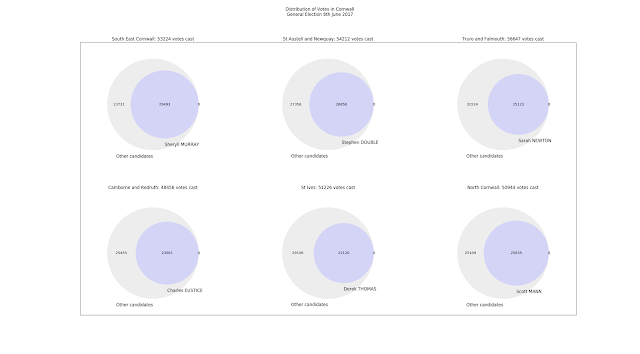Skrifennow
My blog, imported from Blogger and converted using Jekyll.
« Prev
1
2
3
4
5
6
7
8
9
10
11
12
13
14
15
16
17
18
19
20
21
22
23
24
25
26
27
28
29
30
31
32
33
34
35
36
37
38
39
40
41
42
43
44
45
46
47
Next »
Chillis, peppers and tomatoes
After having a propagator for Christmas (and then ordering another one - I now have both the 'self-watering' and heated versions of Garland windowsill propagators) I have started my tomatoes, chillis and sweet peppers for 2018 on the windowsill.
The first to be sown were the cherry tomatoes which went in on 1st Jan:
I also have kept some of the seeds from my own chilli plants I grew from seed in 2016 and 2017, and ordered a mix of sweet pepper seeds online.
The first to be sown were the cherry tomatoes which went in on 1st Jan:
I also have kept some of the seeds from my own chilli plants I grew from seed in 2016 and 2017, and ordered a mix of sweet pepper seeds online.
 |
| Two trays of seeds from 1602, and a tray of seeds from 1701. In 2016 most of my chilli plants died in the greenhouse after going mouldy in November, although I did bring in 4 indoors before then that survived the winter. None of them produced a lot of chillis in the first season. However the 4 that did survive have grown back well this year and some of them have produced a lot of hot, red habenero chillis. I also bought a mixed pack of chilli seeds. 1701 is a yellow chilli, possibly Yellow Cayenne. I also had some seeds of 1708 and 1715 mixed up sown but not pictured here. I think 1708 is another yellow Cayenne, and 1715 is probably Garden Salsa. I also have a couple of green Jalapeno plants but haven't saved seeds from these. There were also a few more habanero in the 2017 batch but their fruits contained very few seeds. |
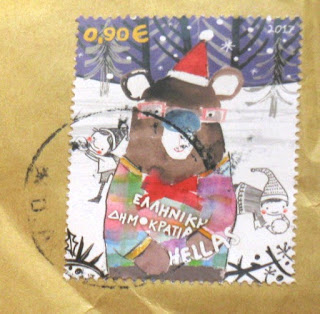 |
| These came from Greece courtesy of vonbondies on eBay. |
BBC complaint fob-off concerning Cornish language confused with dialect
YOUR COMPLAINT:
Complaint Summary: Radio 4 confuse Cornish dialect with the language
Full Complaint:
This is the somewhat confused fob-off I got in response:
Note however that the article has been edited. I have reproduced below the article as it was at the time I made my complaint. Note that the introductory paragraphs are not the same as the current version on the website.




Complaint Summary: Radio 4 confuse Cornish dialect with the language
Full Complaint:
The webpage http://www.bbc.co.uk/programmes/articles/4ptVCHhsT5CDKS2dKXPJnKp/poldark-parlance-14-cornish-phrases-and-what-they-mean which is titled "Poldark parlance: 14 Cornish phrases and what they mean" claims to give a list of 14 words or phrases in Cornish. However except for one they are the English dialect spoken in Cornwall rather than the actual Cornish language. I would have thought Radio 4 would know better than to confuse the Anglo-Cornish dialect with the actual Cornish language, which is distinct from English.
This is the somewhat confused fob-off I got in response:
Thanks for getting in touch regarding BBC Online.
I understand you feel that the Radio 4 page 'Poldark parlance: 14 Cornish phrases and what they mean', confuses the Anglo-Cornish dialect with the Cornish language.
The article doesn't claim to be translating from the Cornish language Kernewek into English.
The introduction explains that the English and Cornish languages intermingled to create a dialect, or what words and phrases which are unique to that specific region.
So in this context, the article is clarifying the meaning of words and phrases used in the English dialect of Cornwall.
That said, we do value your feedback about this issue. All complaints are sent to senior management and online editors every morning and I included your points in this overnight report.
These reports are among the most widely read sources of feedback in the BBC and ensures that your complaint has been seen by the right people quickly. This helps inform their decisions about current and future programmes.
Once again, thank you for contacting us.
Kind regardsBBC Complaints Team
Note however that the article has been edited. I have reproduced below the article as it was at the time I made my complaint. Note that the introductory paragraphs are not the same as the current version on the website.
Poldark parlance: 14 Cornish phrases and what they mean

The Cornish language was thought to have died out with its last fluent, native speakers back in the 18th Century, but Kernewek – or what we know of as Cornish – has been experiencing a recent revival.
With Poldark’s rugged residents due to grace our screens once again, what better opportunity to scrub up on some good, old-fashioned Cornish words and sayings.
1. Aright, my 'ansum?
No, not an enquiry from an admirer or a casual come-on, this is a simple “how are you?” 'Ansum is a universal term of endearment directed at men and women alike, and can be used for strangers as well as friends - handsome or not.2. Dreckly
If someone proffers “I’ll do it dreckly”, don’t expect the task in hand to be completed any time soon. Dreckly is to the Cornish what mañana is to the Spanish – I’ll do it when I’m good and ready and not before. “See you dreckly” is the Cornish “ciao”, or “see you later”. That could mean later that day, tomorrow, or well into the future. You might be waiting around for some time…3. Proper job
Delighted by that cream tea you just ate? “Proper job.” Enchanted with your new wheebarrow? “Proper job.” Thoroughly enjoyed the latest episode of Poldark? “Proper job.” It’s a mark of quality that can be applied to just about anything, not just worthwhile employment.4. Stank
Nothing to do with a nasty smell (although you might whiff after you’ve done one), stank simply means a walk – normally a long and arduous one up a steep hill, what with it being Cornwall: “Arear! That was a fair old stank.”
Proper job.
5. Teddy
Not the popular furry playmate but a crucial ingredient in the much-loved Cornish pasty, teddy is Cornish vernacular for the common and garden spud. Order a teddy oggy for a potato pasty, or a turmut and teddy pie for a dish consisting of meat, potato and turnip under short crust pastry. Delicious.6. Kiddlywink
An unlicensed beer shop, a kiddlywink was permitted to sell beer or cider but not spirits like traditional taverns and inns. So shopkeepers would keep contraband brandy in a kettle under the counter. The knowing clientele, often smugglers and other disreputable types, would then wink at the kettle when they needed a top up. Farm labourers could visit a kiddlywink to receive beer instead of their wages (which probably didn’t go down too well with the rest of the family).7. Chacking
Meaning thirsty, as in “I’m chacking for a cider – if you need me I’ll be at the kiddlywink.”8. Whist
Wan-looking, weak or faint. A characteristic displayed by many a miner, peasant, or urchin in Poldark – not to mention the viewers: after gazing at the broody, shirtless estate owner atop his horse, atop a cliff, many a young woman has been rendered well and truly whist.9. Piddledowndidda?
Like the rest of the British, the Cornish relish a conversation about the weather. This literally translates as “was it raining?” or “get rained on did you?” On a visit to Cornwall, the answer is very likely to be yes.10. Emmet
A derogatory nickname for tourists or outsiders. Literally meaning ant, it’s used by the Cornish locals to describe the summer influx of visitors – often red with sunburn and seen scurrying around the countryside.
Take a stank round here.
11. Teasy as’n adder
Derived from the Cornish word “tesek” meaning “hot-tempered”, teasy can be used to describe an irritable child, or a grumpy adult who deserves to be given a wide berth: “He’s imbibed too much scrumpy, he’s teasy as’n adder!”12. Wasson me cock?
A common greeting. Don’t worry, they’re not asking you to inspect their nether regions for foreign objects – they just want to know what you’re up to.13. Giss on!
Are you pulling my leg? Don’t talk rubbish!14. Kows moy lent mar pleg
Finally, one to remember if you’re planning an imminent trip to the Celtic kingdom of Kernow - it might prove useful if you find yourself out of depth in a conversation with the locals. It simply means “please speak more slowly”.
Proper job, me lover! Now don’t be teasy, settle down dreckly to geek at Poldark with a belly-tember teddy oggy and a gooder sense of what the sumpmen and bal-maidens are all gabbling on about. Bleddy 'ansum that is.
Syllable segmentation: showing an error message if input not understood in full
In my previous post about filling in the gap in Bewnans Ke at the Cornish language weekend, I noticed that the Cornish word 'vyajya' (to travel) is not understood in full by the syllable segmentation module of taklow-kernewek, if the reverse segmentation mode is used starting from the end and working backwards, since it assumes the penultimate syllable is 'yaj' starting with a semivocalic y rather than a vowel y. This leaves 'v' on its own which is not matched by the regular expression as a syllable.
This can be compounded if accented or non-alphabetic characters are included. A warning can now be given in cases where not all of the input word is matched, using the command-line syllabenn_ranna_kw.py with the --warn option, or by checkboxes in sylrannakwGUI.py and sylrannacyGUI.py
This can be compounded if accented or non-alphabetic characters are included. A warning can now be given in cases where not all of the input word is matched, using the command-line syllabenn_ranna_kw.py with the --warn option, or by checkboxes in sylrannakwGUI.py and sylrannacyGUI.py
 |
| The window in my netbook. If the box is ticked, a warning is given. One of my next things to do is to make the output box a little cleverer to avoid splitting lines in the middle of words. |
Pennseythun Gernewek 2017
Back in April I attended the Pennseythun Gernewek, the annual Cornish language weekend run by Kowethas an Yeth Kernewek where Cornish speakers from around Cornwall, and beyond gather to speak the language, and participate in lessons and activities. There is something for every level of previous knowledge of the language, from Dallethoryon Lan (complete beginners) to Bagas Freth (the fluent speakers group). I definitely recommend it.
A couple of things that Bagas Freth did this year was a talk by Ken George on translating song lyrics into Cornish, and a workshop on composing a part of the lost part of Bewnans Ke (events taking place during the missing part of the manuscript before the portion that was preserved).
7 My a'th pys Duw pyth yw res A
4 dhymm gul ragos B
7 A wre'ta ow dannvonn mes A
4 A'n benneglos B
4 Ny wrav govynn C
7 bywnans fethus yn palas D
7 Argheskop gans boes a vlas D
7 gwell yw genev rewlys tynn C
7 Vyajya a wre'ta'n skon A
4 Bys Rosewa B
7 War an mor y glywydh son A
4 Klogh y'n le na B
4 Vydh ow seni C
7 Grasek ov bos yn ayr fresk D
7 Y'n le skrifa orth ow desk D
7 Dhe Gernow mos a wren ni C
The numbers at the left are the number of syllables, and the letters at the right mark the rhymes.
There are two formats used in Bewnans Ke that we followed in composing these stanzas. This had a structure of 7, 4, 7, 4, 4, 7, 7,7 syllables per line. The other possible structure was 7,7,7,7,4,7,7,7. With either of these structures either one person was speaking for all 8 lines, or person 1 for 5 lines and person 2 for 3. In the first of the stanzas above, it is all Ke speaking, and the second has 5 lines of God in reply and 3 with Ke again.
A broad translation is as follows:
I pray God what must I do for thee. Will you send me away from the cathedral?
I do not ask for a luxurious life in an archbishops palace with fine food. I prefer a strict rule.
You will voyage soon, to Rosewa (placename, meaning the Roseland?) On the sea you will hear a sound of a bell ringing there.
I am grateful to be in fresh air rather than writing at my desk. To Cornwall we will go.
One group got a song in French "Charles Trenet - La Mer" which I think was quite a difficult challenge for them. I don't have a copy here of what they came up with.
I was part of a group working on Moon River (Louis Armstrong).
With a bit of artistic licence and adaptation:
A couple of things that Bagas Freth did this year was a talk by Ken George on translating song lyrics into Cornish, and a workshop on composing a part of the lost part of Bewnans Ke (events taking place during the missing part of the manuscript before the portion that was preserved).
Bewnans Ke an Blydhynnyow Kellys
We divided into groups and composed several stanzas covering Ke in his time in Brittany before his coming to Cornwall. I partly composed this:7 My a'th pys Duw pyth yw res A
4 dhymm gul ragos B
7 A wre'ta ow dannvonn mes A
4 A'n benneglos B
4 Ny wrav govynn C
7 bywnans fethus yn palas D
7 Argheskop gans boes a vlas D
7 gwell yw genev rewlys tynn C
7 Vyajya a wre'ta'n skon A
4 Bys Rosewa B
7 War an mor y glywydh son A
4 Klogh y'n le na B
4 Vydh ow seni C
7 Grasek ov bos yn ayr fresk D
7 Y'n le skrifa orth ow desk D
7 Dhe Gernow mos a wren ni C
The numbers at the left are the number of syllables, and the letters at the right mark the rhymes.
There are two formats used in Bewnans Ke that we followed in composing these stanzas. This had a structure of 7, 4, 7, 4, 4, 7, 7,7 syllables per line. The other possible structure was 7,7,7,7,4,7,7,7. With either of these structures either one person was speaking for all 8 lines, or person 1 for 5 lines and person 2 for 3. In the first of the stanzas above, it is all Ke speaking, and the second has 5 lines of God in reply and 3 with Ke again.
A broad translation is as follows:
I pray God what must I do for thee. Will you send me away from the cathedral?
I do not ask for a luxurious life in an archbishops palace with fine food. I prefer a strict rule.
You will voyage soon, to Rosewa (placename, meaning the Roseland?) On the sea you will hear a sound of a bell ringing there.
I am grateful to be in fresh air rather than writing at my desk. To Cornwall we will go.
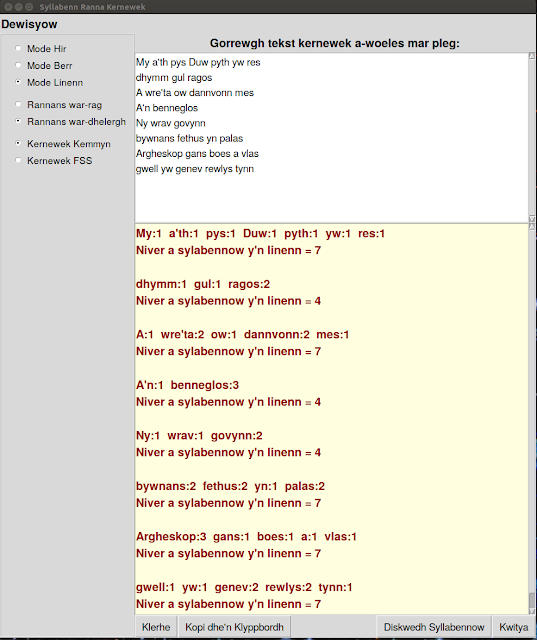 |
| Output of taklow-kernewek syllable segmentation tool. |
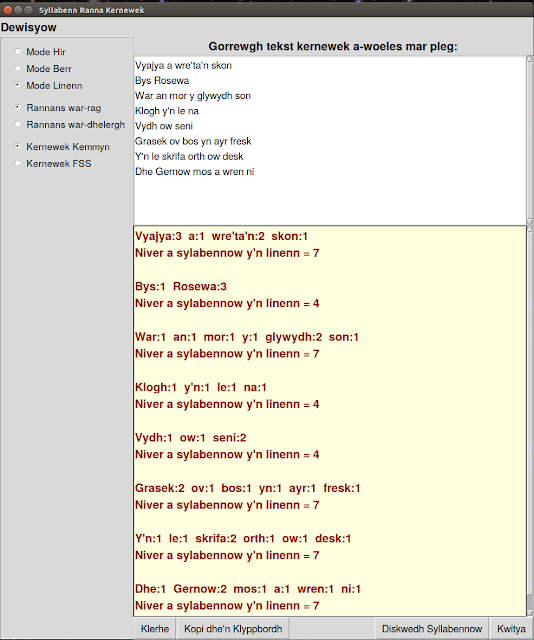 |
| Output of taklow-kernewek syllable segmentation tool. I changed to forward segmentation due to an issue with the word 'vyajya' see below. |
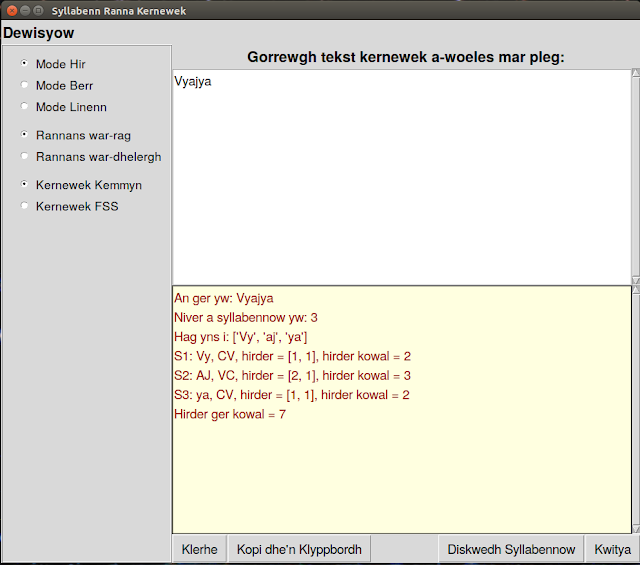 |
| Detailed output for 'Vyajya' - forward segmentation. The regular expression starts at the beginning of the word and works forwards. |
Song lyrics
In another of the sessions, Ken George covered some aspects of translating a song, including observing its metre and rhyme, and the different styles of rhyme in songs. After the talk, we divided into smaller groups and tried translating a song each.One group got a song in French "Charles Trenet - La Mer" which I think was quite a difficult challenge for them. I don't have a copy here of what they came up with.
I was part of a group working on Moon River (Louis Armstrong).
With a bit of artistic licence and adaptation:
Original
Moon river, wider than a mile
I'm crossing you in style some day
Oh, dream maker, you heart breaker
Wherever you're goin', I'm goin' your way
Two drifters, off to see the world
There's such a lot of world to see
We're after the same rainbow's end, waitin' 'round the bend
My huckleberry friend, moon river, and me
I'm crossing you in style some day
Oh, dream maker, you heart breaker
Wherever you're goin', I'm goin' your way
Two drifters, off to see the world
There's such a lot of world to see
We're after the same rainbow's end, waitin' 'round the bend
My huckleberry friend, moon river, and me
Noting rhymes
mile, style
day, way
maker, breaker
world, world
see, me
end, bend, friend
Translation/Adaptation
Dowr Tamar, moy es mildir bras
Y treusyav dha dhowr glas neb jydh
Ty a wra hunros, mestres fell dell os
Pub le a wre'ta mos, ena my a vydh
Dew wandror mos a-dro dhe'n bys
Meur a'n norvys a welyn ni
Ni a helgh penn kammneves, ni a wort a-dro dhe'n kamm
Ha my a wra ri dhis amm
Dowr Tamar, ha my.
General Election 2017 - and trying out the Python pandas library
I am happy to report that my computer is working again, after a reformat, Windows 7 installation, then a long delay while Ubuntu partition resizer stalled, then fixed that with a GParted iso, and then reinstalled Ubuntu 17.04 and I am part way through restoring data from backups.
QGIS is working with version 2.18.
Although I have used Python csv, matplotlib and numpy libraries to read data from files and plot I hadn't used the pandas library for anything much, so I thought I'd do so. I have in previous code often built up a list manually by setting data = [] and then using append to build up the list, which can be slow for large datasets.
First I need some data, and I will use the general election results for the 6 parliamentary constituencies for the House of Commons in Cornwall:
Here is the Python code, which expects the above data in a file called electionresults2017.csv which it reads using csv.DictReader which produces an iterator which I convert to a list and create a pandas data frame object.
The code is also available in the dataviz-sandbox repository at my Bitbucket account.
And the results:
I have also tried out matplotlib_venn. It takes as arguments the keyword subsets, which for the function venn2 expects A and (not B), (not A) and B, and (A and B). Below, voteothers is the number who voted for non-elected candidates, the second is by definition an empty set (those who didn't vote and cast a vote for the winner), and votewinner is those who voted for the winner.
Since Cornwall is a one-party state, the colours can be hard-coded.
The function venn3 expects a 7 element tuple as below. In this case, A is the electorate, B is those who voted for the winner, and C is those who voted for other candidates.
QGIS is working with version 2.18.
Although I have used Python csv, matplotlib and numpy libraries to read data from files and plot I hadn't used the pandas library for anything much, so I thought I'd do so. I have in previous code often built up a list manually by setting data = [] and then using append to build up the list, which can be slow for large datasets.
First I need some data, and I will use the general election results for the 6 parliamentary constituencies for the House of Commons in Cornwall:
Constituency,Surname,Forenames,Description,Votes,Turnout
Camborne and Redruth,EUSTICE,Charles George,Conservative Party,23001,70.96
Camborne and Redruth,WINTER,Graham Robert,Labour Party,21424,70.96
Camborne and Redruth,WILLIAMS,Geoffrey,Liberal Democrats,2979,70.96
Camborne and Redruth,GARBETT,Geoffrey George,Green Party,1052,70.96
North Cornwall,MANN,Scott Leslie,Conservative Party,25835,74.2
North Cornwall,ROGERSON,Daniel John,Liberal Democrats,18635,74.2
North Cornwall,BASSETT,Joy,Labour Party,6151,74.2
North Cornwall,ALLMAN,John William,Christian Peoples Alliance,185,74.2
North Cornwall,HAWKINS,Robert James,Socialist Labour Party,138,74.2
South East Cornwall,MURRAY,Sheryll,Conservative Party,29493,74.2
South East Cornwall,DERRICK,Gareth Gwyn James,Labour Party,12050,74.2
South East Cornwall,HUTTY,Philip Andrew,Liberal Democrats,10346,74.2
South East Cornwall,CORNEY,Martin Charles Stewart,Green Party,1335,74.2
St Austell and Newquay,DOUBLE,Stephen Daniel,Conservative Party,26856,69.3
St Austell and Newquay,NEIL,Kevin Michael,Labour Party,15714,69.3
St Austell and Newquay,GILBERT ,Stephen David John ,Liberal Democrats,11642,69.3
St Ives,THOMAS,Derek,Conservative Party,22120,76.1
St Ives,GEORGE,Andrew Henry,Liberal Democrats,21808,76.1
St Ives,DREW,Christopher John,Labour Party,7298,76.1
Truro and Falmouth,NEWTON,Sarah Louise,Conservative Party,25123,75.9
Truro and Falmouth,KIRKHAM,Jayne Susannah,Labour Party,21331,75.9
Truro and Falmouth,NOLAN,Robert Anthony,Liberal Democrat,8465,75.9
Truro and Falmouth,ODGERS,Duncan Charles,UK Independence Party,897,75.9
Truro and Falmouth,PENNINGTON,Amanda Alice,Green Party,831,75.9
Here is the Python code, which expects the above data in a file called electionresults2017.csv which it reads using csv.DictReader which produces an iterator which I convert to a list and create a pandas data frame object.
The code is also available in the dataviz-sandbox repository at my Bitbucket account.
import matplotlib.pyplot as plt
import pandas as pd
import numpy as np
import csv
def chooseColour(desc):
if desc == "Labour Party":
return "red"
elif "Liberal" in desc:
return "yellow"
elif "Green" in desc:
return "green"
elif "Conservative" in desc:
return "blue"
else:
return "magenta"
with open('electionresults2017.csv', 'r') as spamreader:
dframe = pd.DataFrame(list(csv.DictReader(spamreader)))
consts = set(dframe['Constituency'])
print(consts)
fig = plt.figure()
plt.suptitle("Distribution of Votes in Cornwall\nGeneral Election 8th June 2017")
plt.axis('equal')
plt.xticks([])
plt.yticks([])
for p, c in enumerate(consts):
# print("Constituency of {}".format(c))
surnames = dframe.loc[dframe.Constituency == c, ['Surname']].values
forenames = dframe.loc[dframe.Constituency == c, ['Forenames']].values
descs = [d[0] for d in dframe.loc[dframe.Constituency == c, ['Description']].values]
plotcolours = [chooseColour(d) for d in descs]
forenames = [f for f in forenames]
forename = [f[0].split()[0] for f in forenames]
names = [f+" "+s for f,s in zip(forename, surnames)]
names = [n[0] for n in names]
votes = dframe.loc[dframe.Constituency == c, ['Votes']].values
votes1 = [v[0] for v in votes]
namedescsvotes = [n+"\n"+d+"\n"+v for n,d,v in zip(names, descs, votes1)]
totalvotes = np.sum(votes, dtype=np.int)
# print(totalvotes)
ax = fig.add_subplot(2, 3, p+1)
ax.axis('equal')
ax.set_title("{C}: {t} votes cast".format(C=c, t=totalvotes))
ax.set_xticks([])
ax.set_yticks([])
ax.pie(votes, radius = np.sqrt(totalvotes/50000.0), labels=namedescsvotes, colors=plotcolours, autopct='%1.1f%%')
fig2 = plt.figure()
plt.suptitle("Representation of Cornwall in the House of Commons")
plt.axis('equal')
plt.xticks([])
plt.yticks([])
for p, c in enumerate(consts):
descs = dframe.loc[dframe.Constituency == c, ['Description']].values
descs = descs[0]
plotcolours = [chooseColour(d) for d in descs]
print(descs)
ax = fig2.add_subplot(2, 3, p+1)
ax.axis('equal')
ax.set_title(c)
ax.set_xticks([])
ax.set_yticks([])
ax.pie([1], labels=descs, colors=plotcolours)
plt.show()
And the results:
 |
| In comparison to votes cast, here are the parties represented in the House of Commons for constituencies in Cornwall. |
I have also tried out matplotlib_venn. It takes as arguments the keyword subsets, which for the function venn2 expects A and (not B), (not A) and B, and (A and B). Below, voteothers is the number who voted for non-elected candidates, the second is by definition an empty set (those who didn't vote and cast a vote for the winner), and votewinner is those who voted for the winner.
Since Cornwall is a one-party state, the colours can be hard-coded.
import matplotlib.pyplot as plt
import matplotlib_venn as venn
...
# subsets = (Ab, aB, AB)
v = venn.venn2(subsets=(voteothers, 0, votewinner), set_colors =('lightgray', 'navy'), set_labels=('Other candidates', winnername))
...
The function venn3 expects a 7 element tuple as below. In this case, A is the electorate, B is those who voted for the winner, and C is those who voted for other candidates.
import matplotlib.pyplot as plt
import matplotlib_venn as venn
...
# subsets=(Abc, aBc, ABc, abC, AbC, aBC, ABC)
v = venn.venn3(subsets=(novote, 0, votewinner, 0, voteothers, 0, 0), set_colors =('lightgray', 'blue', 'red'), set_labels=('electoral register', winnername,'Other candidates'))
...
 |
| It would be nice to make the zero sets disappear, maybe there is a way to do this in the documentation somewhere. |
« Prev
1
2
3
4
5
6
7
8
9
10
11
12
13
14
15
16
17
18
19
20
21
22
23
24
25
26
27
28
29
30
31
32
33
34
35
36
37
38
39
40
41
42
43
44
45
46
47
Next »





